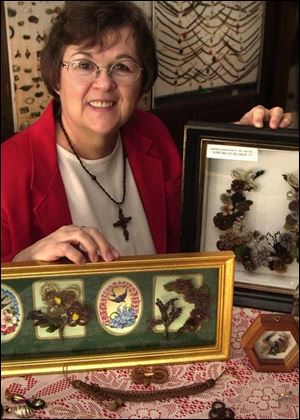
Hair jewelry: Art of 1800s survives today
2/7/2002
Ruth Gordon displays some of her hairwork. Hair jewelry was popular in America during the 19th century.
Most folks consider the hair they lose in brushes and drains a nuisance. But Victorians viewed today's trash as a treasure.
More than a century ago, people saved their lost hair and created works of art, called hairwork, from the fallen strands. Among these projects were brooches, watch fobs, and bracelets. It's the sort of exacting work almost nobody in America makes time for anymore - except Ruth Gordon of Newport, Mich.
“There are half a dozen that I'm personally aware of,” Ms. Gordon said, estimating the number of fellow hairwork practitioners in this country. Her work will be on display Saturday at the Victorian Valentine's Day Celebration in Pemberville, Ohio. She will also demonstrate the craft.
She became interested in hairwork in 1978, when she worked as a guide in the Henry Ford Museum and Greenfield Village in Dearborn, Mich.
“I just fell in love with it,” she said. She found very little research, and eventually taught herself to make hair jewelry from a book she found on microfilm, then learned more from a man in Michigan whose family had handed down the art to him.
Hairwork was a popular fashion statement in the years before the Civil War, and continued to gain followers over the next several decades. Women's magazines of that time gave instructions and patterns for making hair jewelry.
The process started with the brushing of the hair. Many people had special receptacles for collecting hair. Once a person had enough hair for a project - Ms. Gordon said a simple flower can use between 3 and 12 strands - she boiled the hair, then sorted it by length. Building a brooch or bracelet required a mold or a firm base, such as wire.
Although the art came to be associated with mourning, hair jewelry was originally a symbol of love and friendship, perhaps in the same vein as a lock of hair tucked into a locket.
Said Ms. Gordon: “It was a wonderfully artful and sentimental way to remember loved ones.”
Ruth Gordon will demonstrate art of hairwork from 9 a.m. to 4 p.m. Saturday at the Victorian Valentine's Day Celebration at Beeker's General Store, 226 East Front St., Pemberville. The demonstration is free. For details, call 419-287-3274.